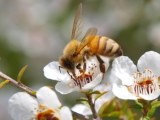By: Kit Mochan
Same plants, same honey … so why does New Zealand want to trademark manuka?
The ongoing fight between Australian and New Zealand manuka honey producers has ratcheted up a notch, with a new Australian industry association staunchly opposing the kiwi push to trademark the “liquid gold” being formed.
The Australian Manuka Honey Association (AMHA) was born out of a meeting in Melbourne last month and is being backed by big industry players including Australia’s largest producer Capilano.
It was around the same time reports emerged of New Zealand producers applying for exclusive trademarks on “manuka honey” in five countries, including Australia and China.
But Australians argue the kiwi claim to what’s been previously dubbed “liquid gold”, which is produced by bees foraging on Leptospermum plants native to both countries, is bunk.
Inaugural AMHA chairman Paul Callender said the group would allow the domestic industry to formalise and fight.
“A number of us agreed that it was time to get the key people involved from the industry together,” he said.
“[New Zealand are] trying to do this trademark globally to prevent access from other manuka countries participating in the markets.
“So we just need to ensure we have free market access globally for our products.”
Manuka honey producers have enjoyed a surge in demand globally, with the New Zealand market tripling in value since 2012, even sparking a wave of recent beehive thefts across the Tasman where hives are valued as high as $2,000 NZ.
Spokesperson for New Zealand’s Unique Manuka Factor Honey Association (UMH) John Rawcliffe is one of the people behind the ongoing trademark push, which began more than two years ago.
He stressed it was not about starting another trans-Tasman feud, but using Geographical Indications (GIs) to protect the multi-million-dollar industry from foreign imitators cashing in and damaging the brand.
“This is not an Australia versus New Zealand story, it’s a consumer story,” he said.
“There is a whole heritage, culture and research behind this unique product from New Zealand that a consumer expects to see or to buy.
“We need to be able to have assurance to that consumer that they are getting that journey.
“So that’s why, like with Champagne, we are looking to protect the term manuka honey.”
Mr Rawcliffe pointed towards the use of GIs in the Australian wine industry.
“It’s like me saying OK let’s call our wine Barossa Valley.
“You know you’ve got some great wines that are singularly named, expressed, differentiated and protected.
“Countries [need to be able to] differentiate and protect their common names, their unique values through GIs, and trade negotiations.”
Would a honey by any other name taste as sweet?
Aside from Capilano, the AMHA board includes representation from the Honeybee Cooperative Research Centre, the Australian Honey Bee Industry Council, and industry experts including scientists.
University of the Sunshine Coast senior chemistry lecturer Dr Peter Brooks, who has been working on researching manuka honey for almost a decade, is one of those people.
“They were first to come up with the activity so they’re thinking Australia is riding on their coattails, which we may be true to a certain extent,” he said.
“But the fact that we’ve got the same product as them makes it very difficult to say that Australians can’t call the same honey by the same name.
“If you look at the chemical profiles of these honeys, it’s almost indistinguishable. They are essentially the same honey.”
Dr Brooks was quick to refute New Zealand’s historical brand claims despite the fact manuka is a Māori word.
“Indigenous Australians did use it … it’s interesting that the Māoris in New Zealand didn’t produce honey … there was no honey produced in New Zealand until the European bee came over there so it was just their name for the tree,” he said.
“But the same name has been used in Australia for about 150 years, there are newspaper articles going back to the mid-1800s talking about manuka plants growing in Australia.”
Can’t we all just get along?
Although New Zealand manuka exports are valued at around 10 times that of Australia’s, sending more than 9,000 tonnes out of the country per annum, Mr Callender said that Australia’s $20 million dollar industry has room to grow.
“[Australia has] very large areas of land that are suitable for planting manuka on a large scale at much lower acquisition and lower operating cost [than New Zealand],” he said.
“You would think that it would be better for us to be collaborating and partnering and looking at joint ventures and strategic investments with the New Zealanders rather than arguing about the word manuka and who owns that.”
Mr Rawcliffe, who has worked with Australian industry before, said he was keen to continue that collaboration but both countries would lose out if they didn’t take the opportunity to trademark their region’s produce.
“We’re very, very keen to share [the science],” he said.
“Differentiating and protecting are key things to enable an industry to actually move forward.
“That’s key to your industry, and that’s going to be the key to our industry.”
AMHA’s chairman Mr Callender respectfully disagreed.
“I’d suggest that’s very kind of him, but I think we’re going to [continue to] use Australian Manuka honey and the brand we’ve got as well,” he said.









